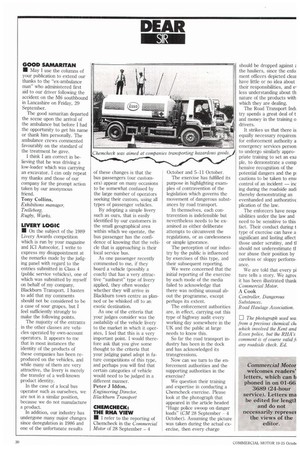DEAR
Page 34

If you've noticed an error in this article please click here to report it so we can fix it.
SIR
• May I use the columns of your publication to extend our thanks to the "ex-ambulance man" who administered first aid to our driver following the accident on the M6 southbound in Lancashire on Friday, 29 September.
The good samaritan departed the scene upon the arrival of the ambulance but before I had the opportunity to get his name or thank him personally. The ambulance crews commented favourably on the standard of the treatment he gave.
I think I am correct in believing that he was driving a Low-loader which was carrying an excavator. I can only repeat my thanks and those of our company for the prompt action taken by our anonymous friend.
Tony Collins,
Exhibitions manager, Trelleborg, Rugby, Warks.
LIVERY LOGIC • Mn the subject of the 1989 Livery Awards competition which is run by your magazine and ICI Autocolor, I write to express my disappointment at the remarks made by the judging panel with regard to the entries submitted in Class 4 (public service vehicles), one of which was submitted by myself on behalf of my company, Blackburn Transport. I hasten to add that my comments should not be considered to be a case of sour grapes, but I feel sufficiently strongly to make the following points.
The majority of the entrants in the other classes are vehicles operated by own-account operators. It appears to me that in most instances the identity of the products of these companies has been reproduced on the vehicles, and while many of them are very attractive, the livery is merely the transfer of a well-known product identity.
In the case of a local bus operator such as ourselves, we are not in a similar position, because we do not manufacture a product.
In addition, our industry has undergone many major changes since deregulation in 1986 and one of the unfortunate results ot these changes is that the bus passengers (our customers) appear on many occasions to be somewhat confused by the large number of operators seeking their custom, using all types of passenger vehicles.
By adopting a simple livery such as ours, that is easily identified by our customers in the small geographical area within which we operate, the bus passenger has the confidence of knowing that the vehicle that is approaching is their local service bus.
As one passenger recently commented to me, if they board a vehicle (possibly a coach) that has a very attractive "sunburst" type of livery applied, they often wonder whether they will arrive in Blackburn town centre as planned or be whisked off to an exotic destination.
As one of the criteria that your judges consider was the suitability of the vehicle livery to the market in which it operates, I feel that this is a very important point. I would therefore ask that you give some thought to the criteria that your judging panel adopt in future competitions of this type, and perhaps you will find that certain categories of vehicle would need to be judged in a different manner.
Peter J Iddon,
Engineering Director, Blackburn Transport CHEMCHECK: THE RHA VIEW • I refer to the reporting of hemcheck in the Commercial Motor of 28 September 4 October and 5-11 October.
The exercise has fulfilled its purpose in highlighting examples of contravention of the legislation which governs the movement of dangerous substances by road transport.
In themselves, each contravention is indefensible but nevertheless needs to be examined as either deliberate attempts to circumvent the regulations, or as carelessness or simple ignorance.
The perception of our industry by the public is influenced by exercises of this type, and their subsequent reporting.
We were concerned that the initial reporting of the exercise by each mode of the media failed to acknowledge that there was nothing unusual about the programme, except perhaps its extent.
The enforcement authorities are, in effect, carrying out this type of highway audit every working day somewhere in the UK and the public at large needs to know this.
So far the road transport industry has been in the dock and has acknowledged its transgressions.
Now can we turn to the enforcement authorities and the supporting authorities in the exercise?
We question their training arid expertise in conducting a Chemcheck exercise. Please look at the photograph that appeared in the article headed "Huge police swoop on danger loads" (CM 28 September 4 October). Assuming the picture was taken during the actual exercise, then every charge
should be dropped against z the hauliers, since the enfo: ment officers depicted cleat have little or no idea about their responsibilities, and e, less understanding about th nature of the products with which they are dealing.
The Road Transport In& try spends a great deal of t and money in the training o drivers.
It strikes us that there is equally necessary requirem for enforcement authority a emergency services person to undergo similarly appropriate training to set an exa ple, to demonstrate a comp hensive recognition of the potential dangers and the pi cautions to be taken to ensi control of an incident — inc ing during the roadside audi thereby demonstrating an evenhanded and authorativ€ plication of the law.
The enforcers have respc sibilities under the law and need to be sensitive to this fact. Their conduct during t type of exercise can have a significant and lasting affect those under scrutiny, and ti should not underestimate ti nor abuse their position by careless or sloppy performance.
We are told that every pi ture tells a story. We agree it has been illustrated thank Commercial Motor.
A Cook
Controller, Dangerous Substances, Road Haulage Association.






























































































































































